Analysis of the Possible Reactivation of the Krbavčići Landslide in Northern Istria, Croatia
Abstract
:1. Introduction
2. Description of the Krbavčići Landslide
3. Methodology
3.1. Laboratory Testing
3.2. Laboratory Test Results
3.3. Slope Stability Analysis and Numerical Simulations of Landslide Reactivation
4. Results of the Slope Stability Analysis and Numerical Simulations of Landslide Reactivation
5. Discussion and Conclusions
Author Contributions
Funding
Acknowledgments
Conflicts of Interest
References
- Velić, I.; Vlahović, I. Geologic Map of Republic of Croatia 1:300.000; Croatian Geological Survey: Zagreb, Croatian, 2009. [Google Scholar]
- Dugonjić Jovančević, S.; Arbanas, Ž. Recent landslides on the Istrian Peninsula, Croatia. Nat. Hazards 2012, 62, 1323–1338. [Google Scholar] [CrossRef]
- Mihljević, D.; Prelogović, E. Structural—Geomorphological characteristic of the mountain ranges Učka & Ćićarija. In Proceedings of the International Symposium Geomorphology and Sea, Meeting of the Geomorphological Commission of the Carpatho-Balkan Countries, Mali Lošinj, Croatia, 22–26 September 1992; pp. 13–24. [Google Scholar]
- Arbanas, Z.; Dugonjic, S.; Benac, C. Causes of small scale landslides in flysch deposits of Istria, Croatia. In Landslide Science and Practice: Landslide Inventory and Susceptibility and Hazard Zoning; Margottini, C., Canuti, P., Sassa, K., Eds.; Springer: Rome, Italy, 2013; Volume 1, pp. 221–226. ISBN 9783642313240. [Google Scholar]
- Arbanas, Ž.; Mihalić Arbanas, S.; Dugonjić Jovančević, S.; Vivoda, M. Brus landslide, translational block sliding in flysch rock mass. In Proceedings of the European Rock Mechanics Symposium (Eurock 2010), Laussane, Switzerland, 15–18 June 2010; pp. 635–638. [Google Scholar]
- Arbanas, Ž.; Benac, Č.; Jurak, V. Causes of debris flow formation in flysch area of North Istria, Croatia. In Monitoring, Simulation, Prevention and Remediation of Dense and Debris Flows; Lorenzini, G., Brebbia, C.A., Emmanouloudis, D., Eds.; WIT Transaction on Ecology and the Environment: Southampton, UK, 2006; Volume 90, pp. 283–292. [Google Scholar]
- Žufić, E. Investigation of Geotehnical Properties of Flysch Rock Mass in Istria Area. Master’s Thesis, University of Zagreb, Zagreb, Croatia, 2011. [Google Scholar]
- Gulam, V. The Erosion of Flysch Badlands in the Central Istria. Ph.D. Thesis, University of Zagreb, Zagreb, Croatia, 2012. [Google Scholar]
- Chandler, R.J. The effects of weathering on the shear strength properties of Keupler marl. Geotehnique 1969, 19, 321–334. [Google Scholar] [CrossRef]
- Reiβmüller, M. Geotechnische Eigenschaften Verwitterter Kfssener Mergel. Ph.D. Thesis, Technical University of Munich, Munich, Germany, 1997. [Google Scholar]
- Bhattarai, P.; Marui, H.; Tiwari, B.; Watanabe, N.; Tuladhar, G.; Aoyama, K. Influence of Weathering on Physical and Mechanical Properties of Mudstone. In Disaster Mitigation of Debris Flows, Slope Failures and Landslides; Universal Academy Press, Inc.: Tokyo, Japan, 2006; pp. 467–479. [Google Scholar]
- Vivoda Prodan, M.; Arbanas, Ž. Weathering Influence on Properties of Siltstones from Istria, Croatia. Adv. Mater. Sci. Eng. 2016, 2016. [Google Scholar] [CrossRef] [Green Version]
- Vivoda Prodan, M. The Influence of Weathering Process on Residual Shear Strength of Fine Grained Lithological Flysch Components. Ph.D. Thesis, University of Rijeka, Rijeka, Croatia, 2016. [Google Scholar]
- Vivoda Prodan, M.; Mileusnić, M.; Mihalić Arbanas, S.; Arbanas, Ž. Influence of weathering processes on the shear strength of siltstones from a flysch rock mass along the North Croatian Adriatic Coast. Bull. Eng. Geol. Environ. 2017, 76, 695–711. [Google Scholar] [CrossRef]
- Maček, M.; Petkovšek, A.; Arbanas, Ž.; Mikoš, M. Geotechnical aspects of landslides in flysch in Slovenian and Croatian. In Proceedings of the 2nd ReSyLAB—Regional Symposium on Landslides in the Adriatic-Balkan Region, Belgrade, Serbia, 14–16 May 2015; pp. 25–30. [Google Scholar]
- Peranić, J. Importance of Geotechnical Cross-Section Unsaturated Zone for Landslide Occurrence in Flysch Deposits. Ph.D. Thesis, University of Rijeka, Rijeka, Croatia, 2019. [Google Scholar]
- Peranić, J.; Arbanas, Ž.; Cuomo, S.; Maček, M. Soil-water characteristic curve of residual soil from a flysch rock mass. Geofluids 2018. [Google Scholar] [CrossRef]
- Peranić, J.; Arbanas, Ž. Impact of the wetting process on the hydro-mechanical behavior of unsaturated residual soil from flysch rock mass: Preliminary results. Bull. Eng. Geol. Environ. 2020, 79, 985–998. [Google Scholar] [CrossRef]
- Peranić, J.; Moscariello, M.; Cuomo, S.; Arbanas, Ž. Hydro-mechanical properties of unsaturated residual soil from a flysch rock mass. Eng. Geol. 2020, 269, 105546. [Google Scholar] [CrossRef]
- Dugonjić Jovančević, S.; Rubinić, J.; Arbanas, Ž. Conditions and triggers of landslides on flysch slopes in Istria, Croatia. Eng. Rev. 2020, 40, 77–87. [Google Scholar]
- Dugonjić Jovančević, S.; Arbanas, Ž. Influence of the runout potential on landslide-susceptible areas along the flysch–karst contact in Istria, Croatia. Nat. Hazards 2017, 85, 1347–1362. [Google Scholar] [CrossRef]
- Eberhardt, E.; Thuro, K.; Luginbuehl, M. Slope instability mechanisms in dipping interbedded conglomerates and weathered marls—The 1999 Rufi landslide, Switzerland. Eng. Geol. 2005, 77, 35–56. [Google Scholar] [CrossRef]
- Miščević, P.; Števanić, D.; Štambuk-Cvitanović, N. Slope instability mechanisms in dipping conglomerates over weathered marls: Bol landslide, Croatia. Environ. Geol. 2009, 56, 1417–1426. [Google Scholar] [CrossRef]
- Zhang, L.L.; Fredlund, D.G.; Fredlund, M.D.; Wilson, G.W. Modeling the unsaturated soil zone in slope stability analysis. Can. Geotech. J. 2014, 51, 1384–1398. [Google Scholar] [CrossRef]
- Berti, M.; Bertello, L.; Bernardi, A.R.; Caputo, G. Back analysis of a large landslide in a flysch rock mass. Landslides 2017, 14, 2041–2058. [Google Scholar] [CrossRef]
- Kogut, J.P.; Pilecka, E.; Szwarkowski, D. Analysis of landslide effects along a road located in the Carpathian flysch. Open Geosci. 2018, 10, 517–531. [Google Scholar] [CrossRef]
- Santo, A.; Di Crescenzo, G.; Forte, G.; Papa, R.; Pirone, M.; Urciuoli, G. Flow-type landslides in pyroclastic soils on flysch bedrock in southern Italy: The Bosco de’ Preti case study. Landslides 2018, 15, 63–82. [Google Scholar] [CrossRef]
- Anagnostopoulou, S.; Boumpoulis, V.; Lampropoulou, P.; Servou, A.; Depountis, N.; Sabatakakis, N. The Behavior of the Highly Weathered and Partially Decomposed Flysch in the Reactivation of Landslide Phenomena in Greece BT. In Proceedings of the IAEG/AEG Annual Meeting Proceedings, San Francisco, CA, USA, 17–21 September 2018; pp. 119–124. [Google Scholar]
- Zabuski, L. Three-Dimensional Analysis of a Landslide Process on a Slope in Carpathian Flysch. Arch. Hydro Eng. Environ. Mech. 2019, 66, 27–45. [Google Scholar] [CrossRef] [Green Version]
- Miščević, P.; Vlastelica, G. Time-dependent stability of slopes excavated in marl. Građevinar 2012, 64, 451–461. [Google Scholar]
- Dugonjić Jovančević, S.; Nagai, O.; Sassa, K.; Arbanas, Ž. Deterministic landslide susceptibility analyses using LS-Rapid software. In Proceedings of the 1st Regional Symposium on Landslides in the Adriatic-Balkan Region “Landslide and Flood Hazard Assessment”, Zagreb, Croatia, 6–9 March 2013; pp. 73–77. [Google Scholar]
- Vivoda, M.; Dugonjić Jovančević, S.; Arbanas, Ž. Landslide Occurrence Prediction in the Rječina River Valley as a Base for an Early Warning System. In Proceedings of the 1st Regional Symposium on Landslides in the Adriatic-Balkan Region “Landslide and Flood Hazard Assessment”, Zagreb, Croatia, 6–9 March 2013; pp. 85–90. [Google Scholar]
- Arbanas, Ž.; Mihalić Arbanas, S.; Vivoda Prodan, M.; Peranić, J.; Sečanj, M.; Bernat Gazibara, S.; Krkač, M. Preliminary Investigations and Numerical Simulations of a Landslide Reactivation BT—Advancing Culture of Living with Landslides; Mikoš, M., Tiwari, B., Yin, Y., Sassa, K., Eds.; Springer International Publishing: Cham, Germany, 2017; pp. 649–657. [Google Scholar]
- Vivoda Prodan, M.; Arbanas, Ž. Parametric Analysis of Weathering Effect on Possible Reactivation of the Valići Landslide, Croatia BT—Advancing Culture of Living with Landslides; Mikoš, M., Tiwari, B., Yin, Y., Sassa, K., Eds.; Springer International Publishing: Cham, Germany, 2017; pp. 621–631. [Google Scholar]
- Peranić, J.; Jagodnik, V.; Arbanas, Ž. Rainfall infiltration and stability analysis of an unsaturated slope in residual soil from flysch rock mass. In Proceedings of the XVII ECSMGE-2019 “Geotechnical Engineering Foundation of the Future”, Reykjavik, Iceland, 1–6 September 2019; pp. 1–8. [Google Scholar]
- Collins, B.D.; Dobroslav, Z. Stability Analyses of Rainfall Induced Landslides. J. Geotech. Geoenviron. Eng. 2004, 130, 362–372. [Google Scholar] [CrossRef]
- Springman, S.M.; Thielen, A.; Kienzler, P.; Friedel, S. A long-term field study for the investigation of rainfall-induced landslides. Géotechnique 2013, 63, 1177–1193. [Google Scholar] [CrossRef]
- Giordan, D.; Hayakawa, Y.; Nex, F.; Remondino, F.; Tarolli, P. Review article: The use of remotely piloted aircraft systems (RPASs) for natural hazards monitoring and management. Nat. Hazards Earth Syst. Sci. 2018, 18, 1079–1096. [Google Scholar] [CrossRef] [Green Version]
- Westoby, M.J.; Brasington, J.; Glasser, N.F.; Hambrey, M.J.; Reynolds, J.M. ‘Structure-from-Motion’ photogrammetry: A low-cost, effective tool for geoscience applications. Geomorphology 2012, 179, 300–314. [Google Scholar] [CrossRef] [Green Version]
- Chao, H.; Cao, Y.; Chen, Y. Autopilots for small unmanned aerial vehicles: A survey. Int. J. Control. Autom. Syst. 2010, 8, 36–44. [Google Scholar] [CrossRef]
- Kaiser, A.; Neugirg, F.; Rock, G.; Müller, C.; Haas, F.; Ries, J.; Schmidt, J. Small-Scale Surface Reconstruction and Volume Calculation of Soil Erosion in Complex Moroccan Gully Morphology Using Structure from Motion. Remote Sens. 2014, 6, 7050–7080. [Google Scholar] [CrossRef] [Green Version]
- Dugonjić Jovančević, S.; Peranić, J.; Ružić, I.; Arbanas, Ž. Analysis of a historical landslide in the Rječina River Valley, Croatia. Geoenviron. Dis. 2016, 3, 26. [Google Scholar] [CrossRef] [Green Version]
- Fernández, T.; Pérez, J.L.; Cardenal, J.; Gómez, J.M.; Colomo, C.; Delgado, J. Analysis of Landslide Evolution Affecting Olive Groves Using UAV and Photogrammetric Techniques. Remote Sens. 2016, 8, 837. [Google Scholar] [CrossRef] [Green Version]
- Chudý, F.; Slámová, M.; Tomaštík, J.; Prokešová, R.; Mokroš, M. Identification of Micro-Scale Landforms of Landslides Using Precise Digital Elevation Models. Geosciences 2019, 9, 117. [Google Scholar] [CrossRef] [Green Version]
- Godone, D.; Allasia, P.; Borrelli, L.; Gullà, G. UAV and Structure from Motion Approach to Monitor the Maierato Landslide Evolution. Remote Sens. 2020, 12, 1039. [Google Scholar] [CrossRef] [Green Version]
- Frodella, W.; Elashvili, M.; Spizzichino, D.; Gigli, G.; Adikashvili, L.; Vacheishvili, N.; Kirkitadze, G.; Nadaraia, A.; Margottini, C.; Casagli, N. Combining InfraRed Thermography and UAV Digital Photogrammetry for the Protection and Conservation of Rupestrian Cultural Heritage Sites in Georgia: A Methodological Application. Remote Sens. 2020, 12, 892. [Google Scholar] [CrossRef] [Green Version]
- Hapke, C.; Richmond, B. Monitoring beach morphology changes using small-format aerial photography and digital softcopy photogrammetry. Environ. Geosci. 2000, 7, 32–37. [Google Scholar] [CrossRef]
- Mancini, F.; Dubbini, M.; Gattelli, M.; Stecchi, F.; Fabbri, S.; Gabbianelli, G. Using Unmanned Aerial Vehicles (UAV) for High-Resolution Reconstruction of Topography: The Structure from Motion Approach on Coastal Environments. Remote Sens. 2013, 5, 6880–6898. [Google Scholar] [CrossRef] [Green Version]
- Ružić, I.; Marović, I.; Vivoda, M.; Dugonjić Jovančević, S.; Kalajžić, D.; Benac, Č.; Ožanić, N. Application of Structure-from-Motion photogrammetry for erosion processes monitoring, Mosčenička Draga example. In Proceedings of the 4th Workshop of the Japanese-Croatian Project on “Risk Identification and Land-Use Planning for Disaster Mitigation of Landslides and Floods in Croatia”, Split, Croatia, 12–14 December 2013; pp. 49–50. [Google Scholar]
- Pikelj, K.; Ružić, I.; Ilić, S.; James, M.R.; Kordić, B. Implementing an efficient beach erosion monitoring system for coastal management in Croatia. Ocean. Coast. Manag. 2018, 156, 223–238. [Google Scholar] [CrossRef] [Green Version]
- Laporte-Fauret, Q.; Marieu, V.; Castelle, B.; Michalet, R.; Bujan, S.; Rosebery, D. Low-Cost UAV for High-Resolution and Large-Scale Coastal Dune Change Monitoring Using Photogrammetry. J. Mar. Sci. Eng. 2019, 7, 63. [Google Scholar] [CrossRef] [Green Version]
- Kerle, N.; Nex, F.; Gerke, M.; Duarte, D.; Vetrivel, A. UAV-Based Structural Damage Mapping: A Review. ISPRS Int. J. Geo-Inf. 2020, 9, 14. [Google Scholar] [CrossRef] [Green Version]
- Pepe, M.; Costantino, D.; Crocetto, N.; Restuccia Garofalo, A. 3D modeling of roman bridge by the integration of terrestrial and uav photogrammetric survey for structural analysis purpose. ISPRS Int. Arch. Photogramm. Remote Sens. Spat. Inf. Sci. 2019, XLII-2/W17, 249–255. [Google Scholar] [CrossRef] [Green Version]
- Tkac, M.; Mesaros, P.; Behun, M.; Mandicak, T. Aerial Photogrammetry and Unmanned Aerial Vehicles (UAVs) Like a Smart Technology for Digital As-Built Mapping of Existing Buildings BT. In Proceedings of the 4th EAI International Conference on Management of Manufacturing Systems; Knapcikova, L., Balog, M., Perakovic, D., Perisa, M., Eds.; Springer International Publishing: Cham, Germany, 2020; pp. 43–51. [Google Scholar]
- Kordić, B.; Pribičević, B.; Đapo, A.; Babić, L.; Govorčin, M. Application of UAS for Spatial Data Acquisition. In Proceedings of the International Symposium on Engineering Geodesy, Varaždin, Croatia, 20–22 May 2016; pp. 539–546. [Google Scholar]
- Hassler, S.C.; Baysal-Gurel, F. Unmanned Aircraft System (UAS) Technology and Applications in Agriculture. Agronomy 2019, 9, 618. [Google Scholar] [CrossRef] [Green Version]
- Engineering-Geological Report, Landslides Krbavčići I and Krbavčići II near the City of Buzet. Rijekaprojekt: Rijeka, Croatia, 1979.
- Inventory. (WP/WLI) International Geotechnical Society’s UNESCO Working Party on World Landslide a Multi-Lingual Landslide Glossary; Bitech Publishers: Vancouver, BC, Canada, 1993. [Google Scholar]
- Skempton, A.W.; Hutchinson, J.N. Stability of natural slopes and embankment foundations. In Proceedings of the 7th International Conference on Soil Mechanics and Foundation Engineering, Mexico City, Mexico, 22–31 August 1969; pp. 291–340. [Google Scholar]
- Hungr, O.; Leroueil, S.; Picarelli, L. The Varnes classification of landslide types, an update. Landslides 2014, 11, 167–194. [Google Scholar] [CrossRef]
- Cruden, D.M.; Varnes, D.J. Landslide Type and Processes. Landslides: Investigation and Mitigation. In Special Report 247; Turner, A.K., Schuster, R.L., Eds.; Transportation Research Board, National Research Council: Washington, DC, USA, 1996; pp. 36–75. [Google Scholar]
- Brown, E.T. Rock Characterization, Testing & Monitoring: ISRM Suggested Methods; Commission on Testing Methods; International Society for Rock Mechanics; Pergamon Press: Oxford, UK, 1981; ISBN 9780080273099. [Google Scholar]
- Sassa, K.; Fukuoka, H.; Wang, G.; Ishikawa, N. Undrained dynamic-loading ring-shear apparatus and its application to landslide dynamics. Landslides 2004, 1, 7–19. [Google Scholar] [CrossRef]
- Oštrić, M.; Sassa, K.; Ljutić, K.; Vivoda, M.; He, B.; Takara, K. Manual of transportable ring shear apparatus, ICL-1. In Proceedings of the 1st Regional Symposium on Landslides in the Adriatic-Balkan Region “Landslide and Flood Hazard Assessment”, Zagreb, Croatia, 6–9 March 2013; pp. 1–4. [Google Scholar]
- Sassa, K.; Nagai, O.; Solidum, R.; Yamazaki, Y.; Ohta, H. An integrated model simulating the initiation and motion of earthquake and rain induced rapid landslides and its application to the 2006 Leyte landslide. Landslides 2010, 7, 219–236. [Google Scholar] [CrossRef]
- Vivoda, M.; Benac, Č.; Žic, E.; Đomlija, P.; Dugonjić Jovančević, S. Geohazards in the Rječina valley in the past and present. Croat. Waters J. Water Econ. 2012, 20, 105–116. [Google Scholar]
- Borgatti, L.; Corsini, A.; Barbieri, M.; Sartini, G.; Truffelli, G.; Caputo, G.; Puglisi, C. Large reactivated landslides in weak rock masses: A case study from the Northern Apennines (Italy). Landslides 2006, 3, 115. [Google Scholar] [CrossRef]
- Petkovšek, A.; Fazarinc, R.; Kočevar, M.; Maček, M.; Majes, B.; Mikoš, M. The Stogovce landslide in SW Slovenia triggered during the September 2010 extreme rainfall event. Landslides 2011, 8, 499–506. [Google Scholar] [CrossRef]
- Tacher, L.; Bonnard, C. Hydromechanical modelling of a large landslide considering climate change conditions. Landslides Clim. Chang. Chall. Solut. 2007, 131–141. [Google Scholar]

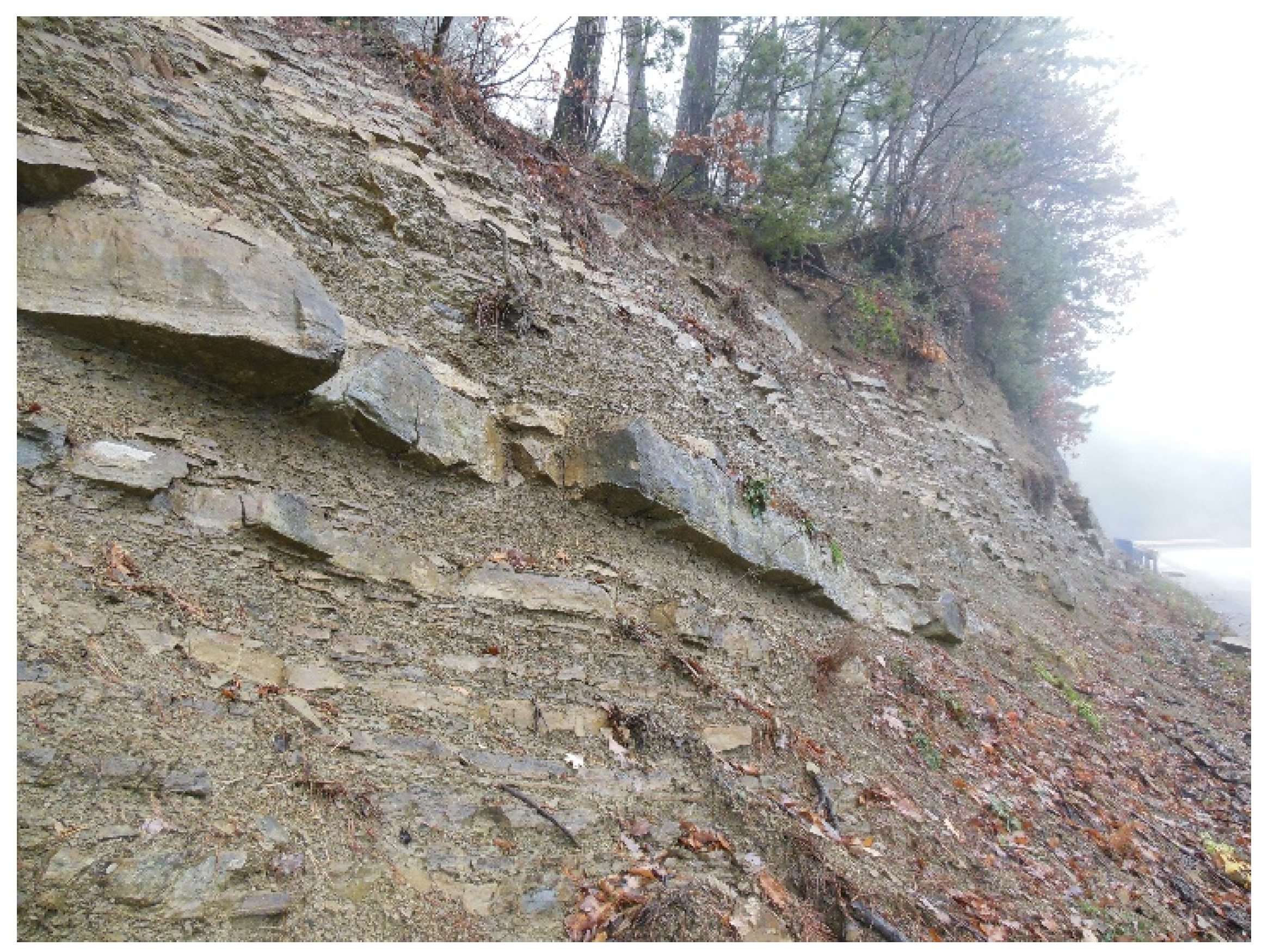

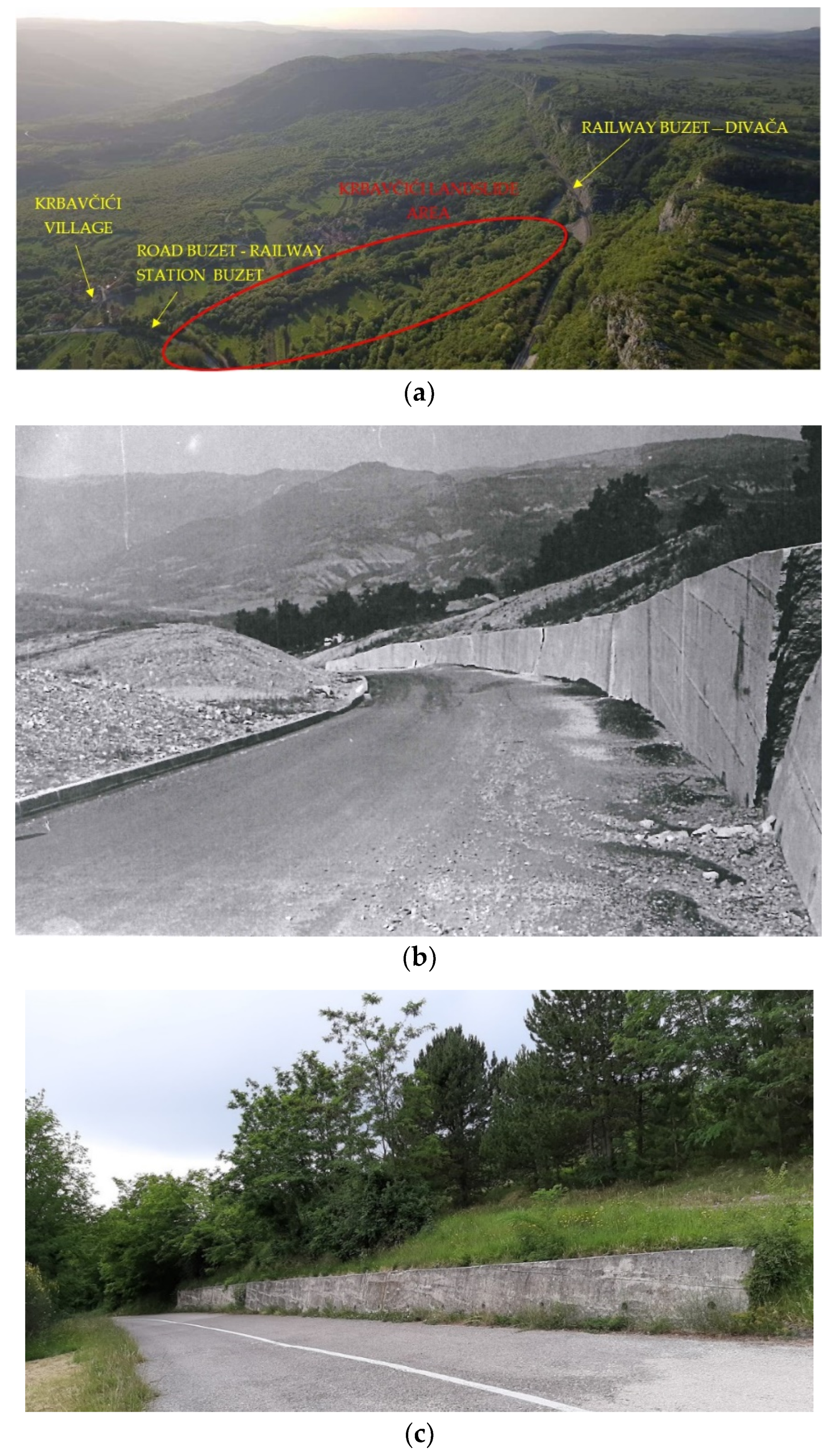



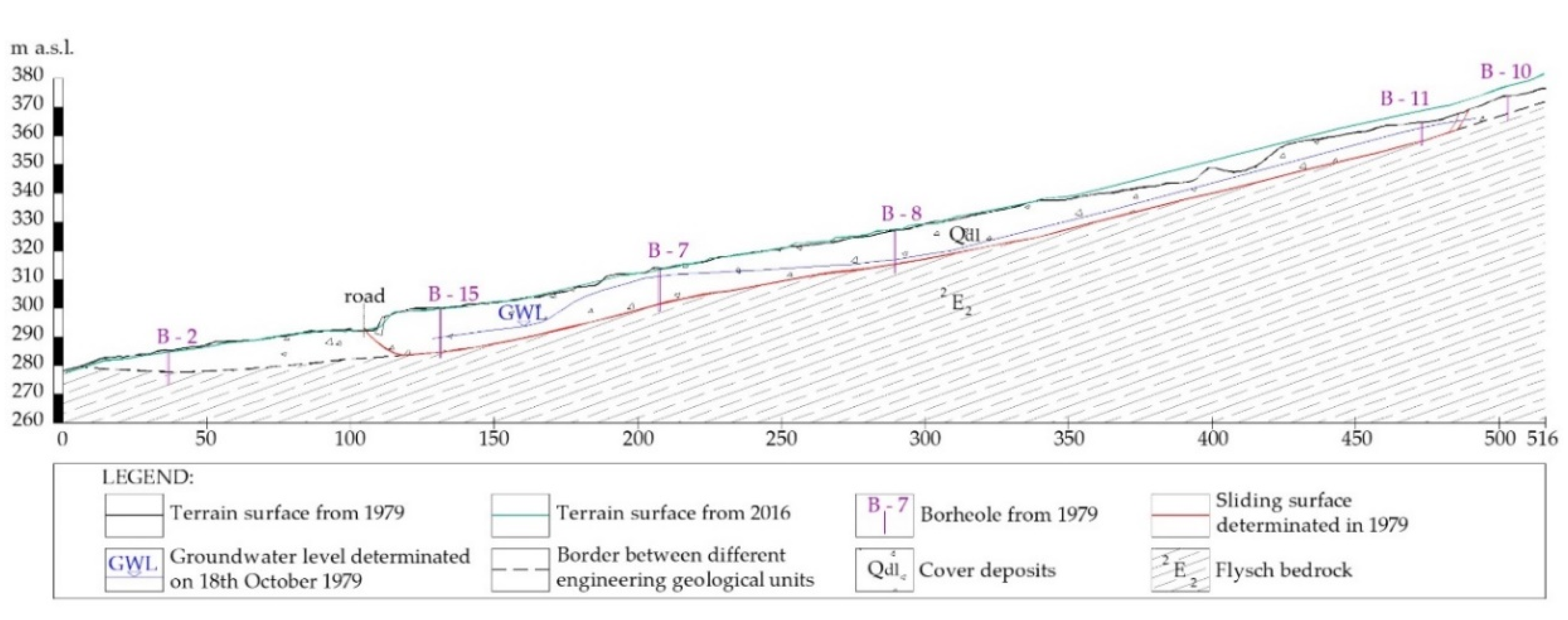
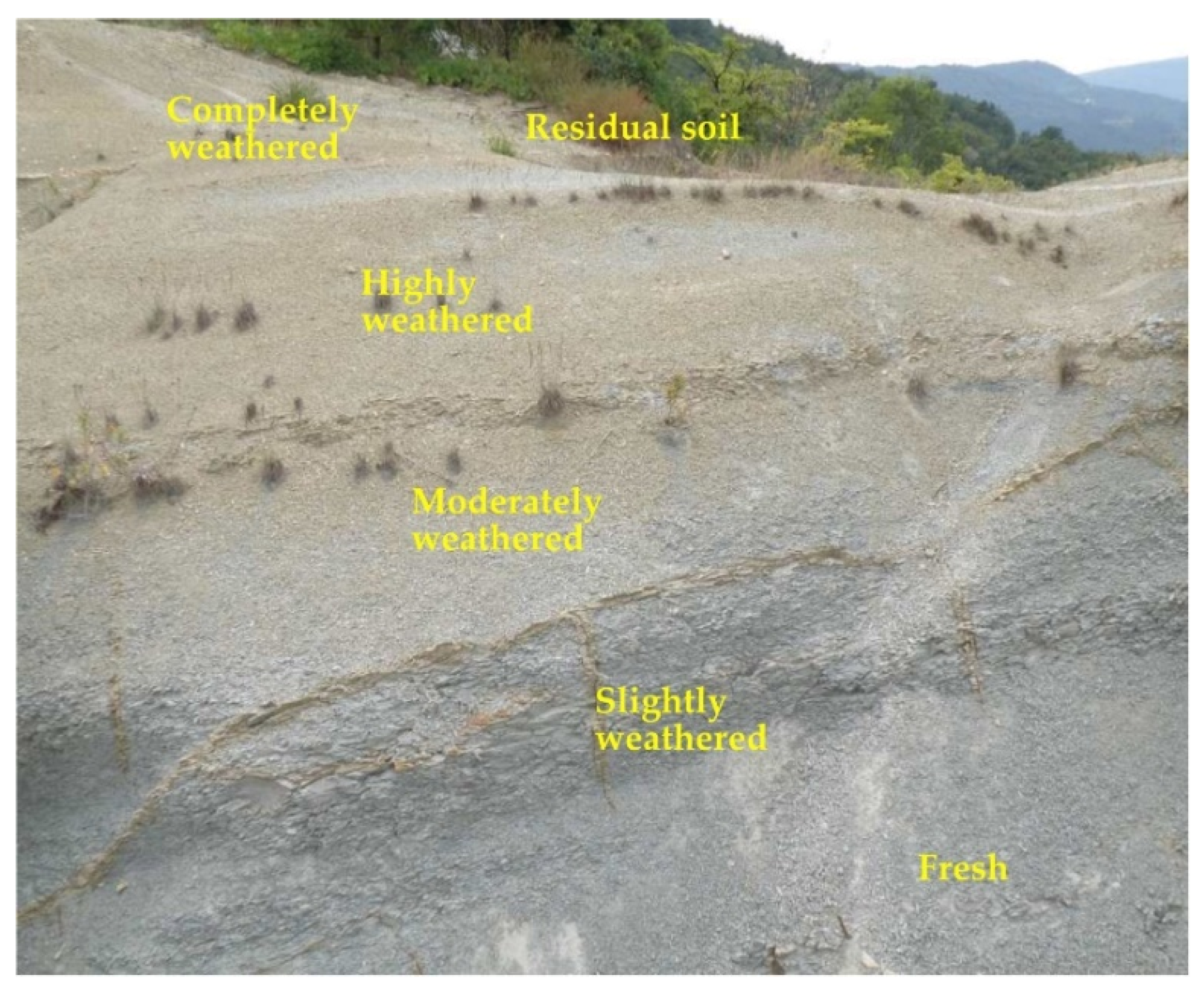
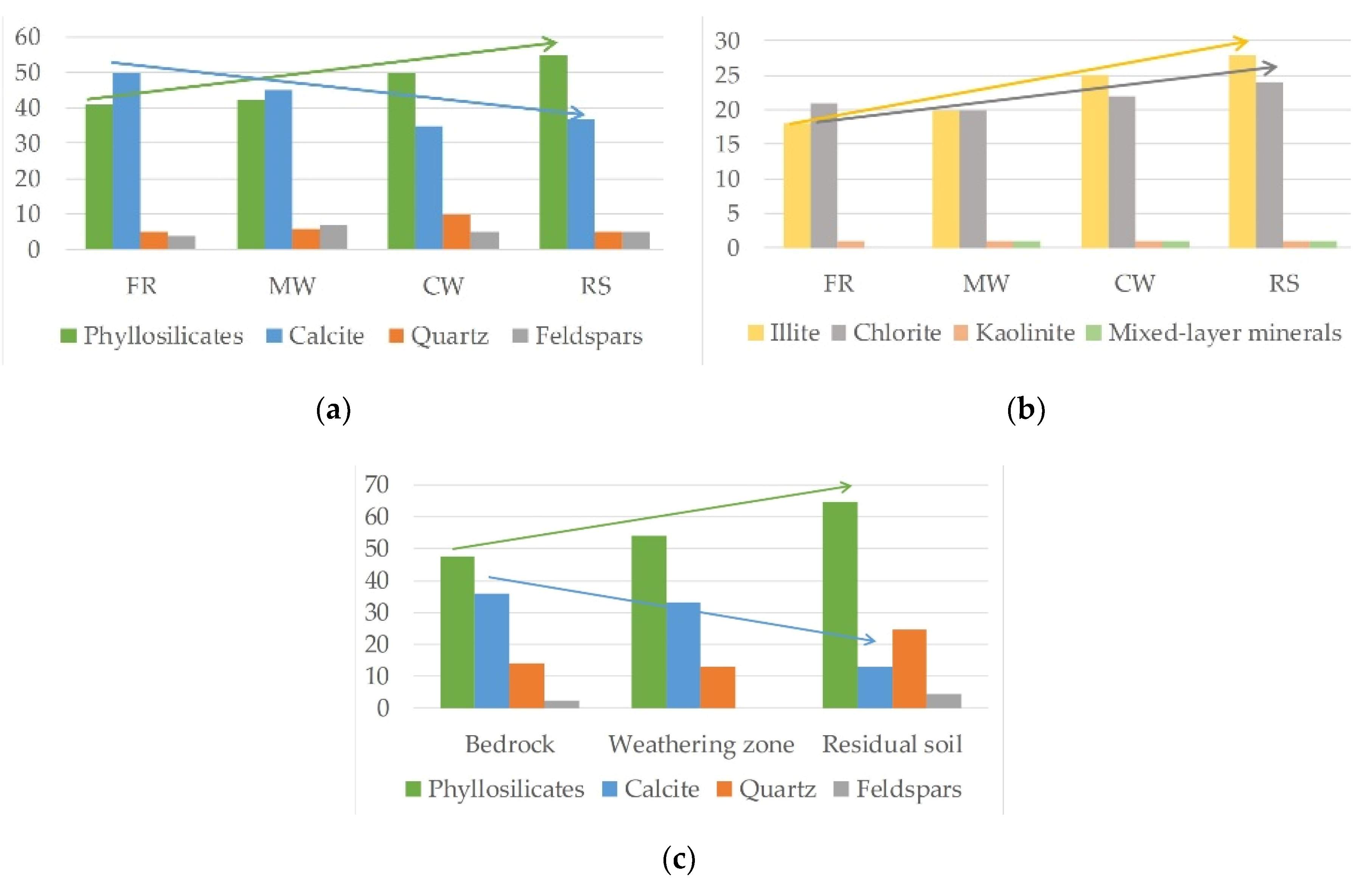

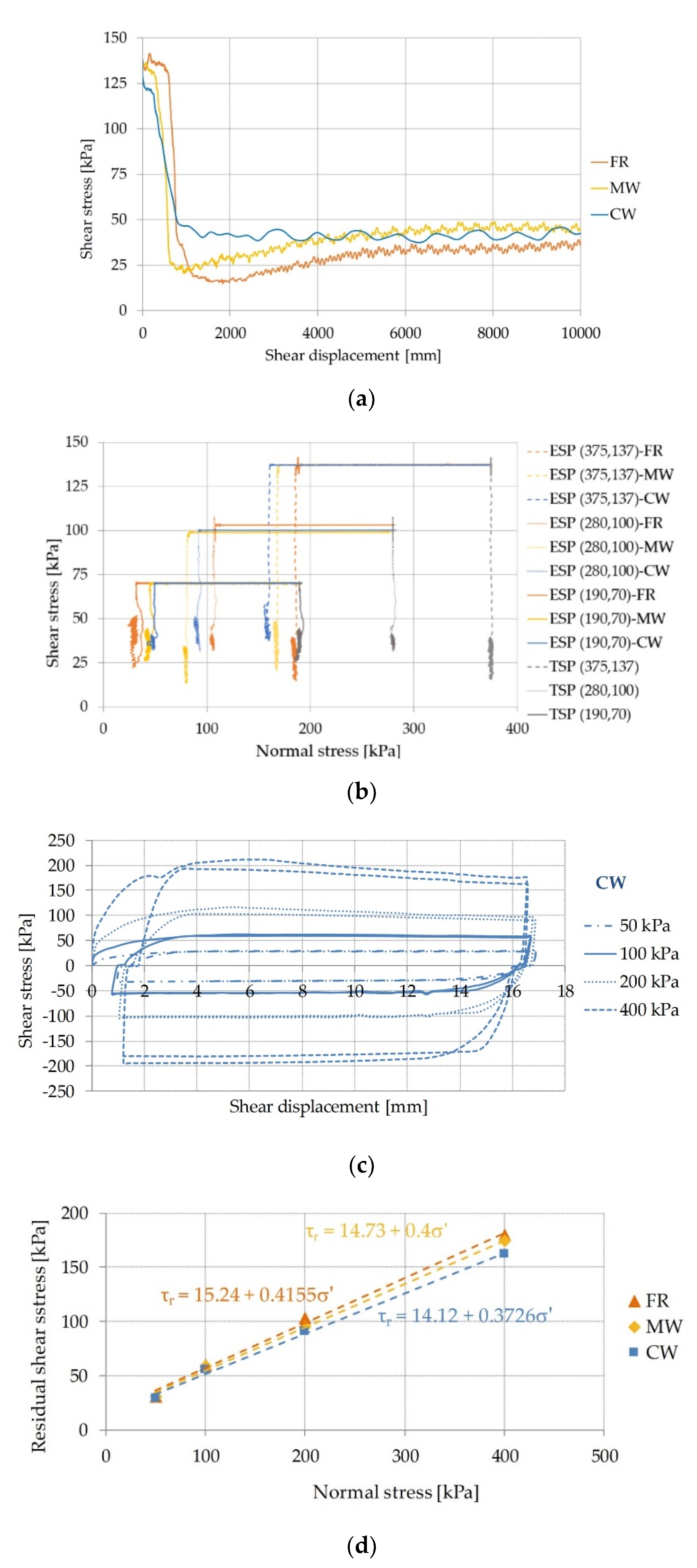
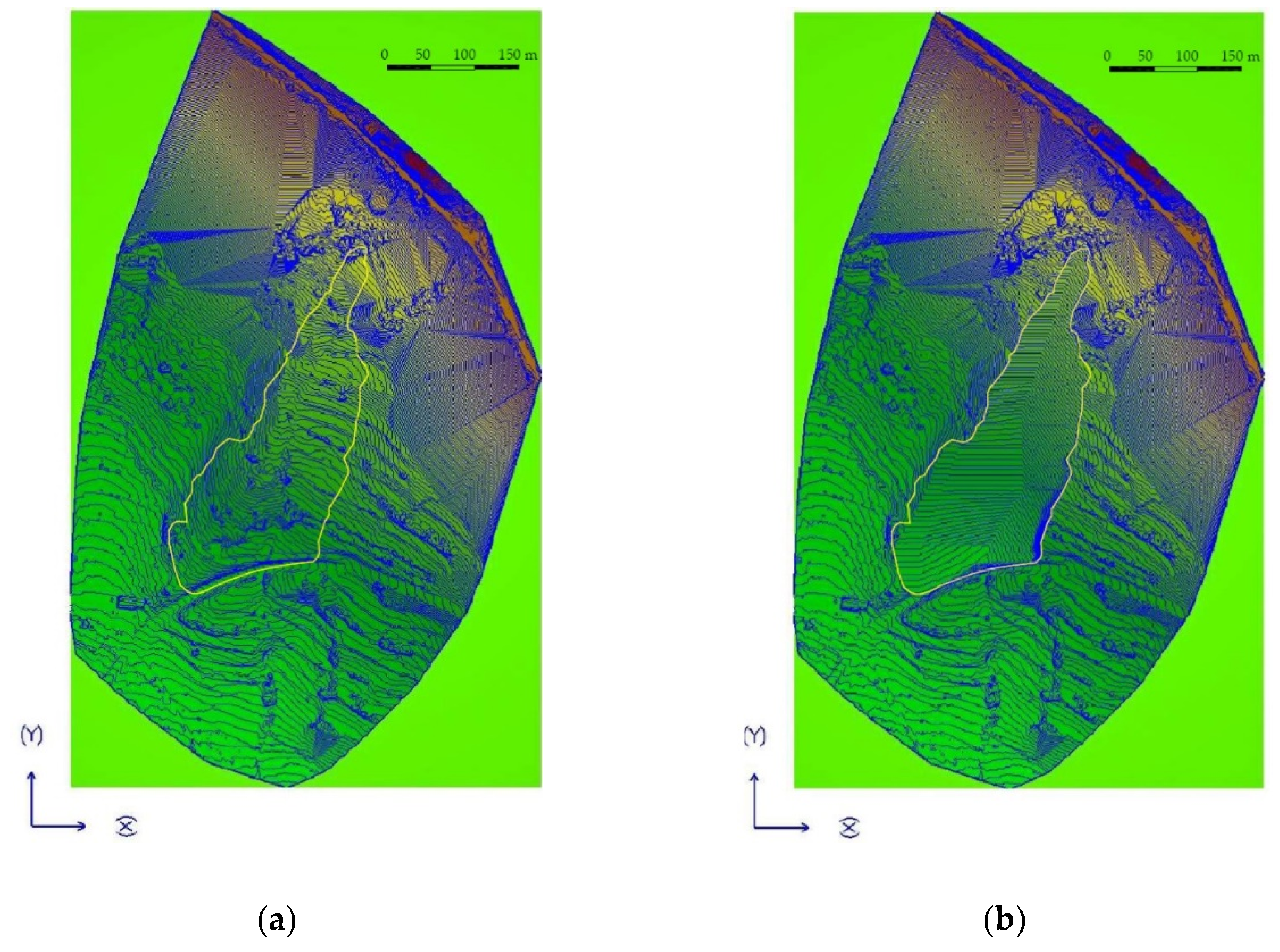
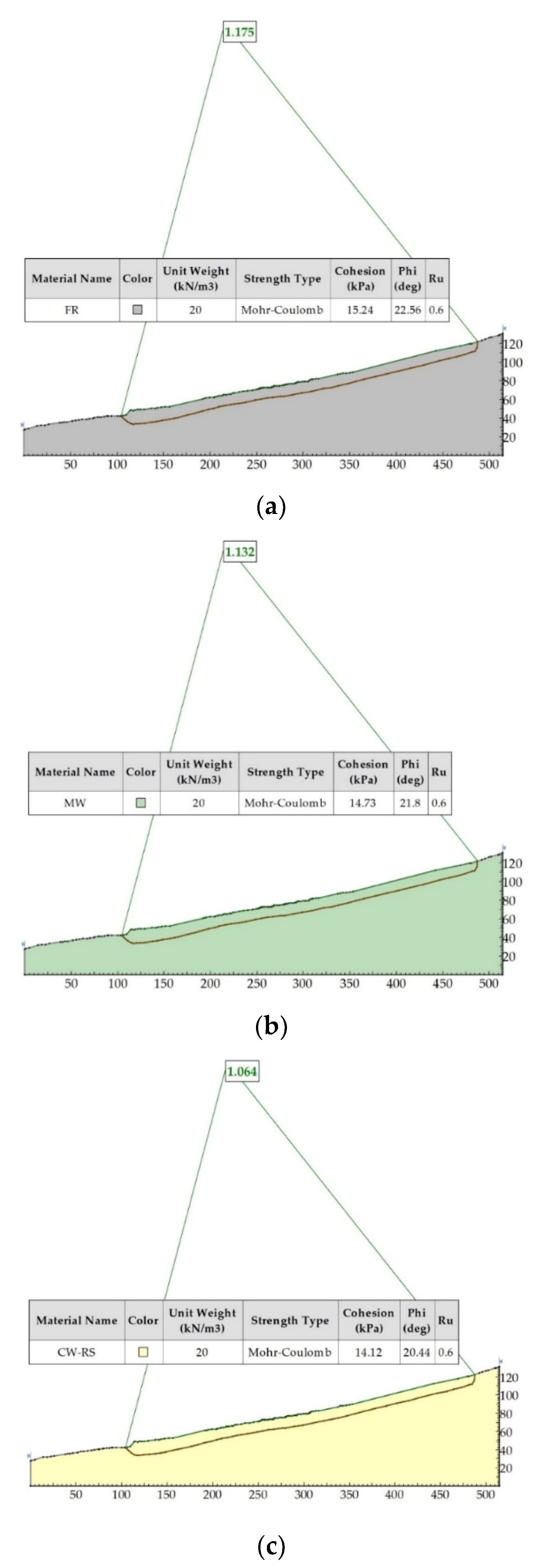


| Term | Symbol | Direct Shear Test | Ring Shear Test | |||
|---|---|---|---|---|---|---|
| ϕr (°) | cr (kPa) | ϕr (°) | cr (kPa) | τss (kPa) | ||
| Fresh | FR | 22.56 | 15.24 | 23 | 56 | 38 |
| Moderately weathered | MW | 21.8 | 14.73 | 27 | 51 | 44 |
| Completely weathered | CW | 20.44 | 14.12 | 31 | 42 | 42 |
| Parameter | Parameter Values Depending on the Weathering Grade of Siltstones from Flysch Rock Mass | ||
|---|---|---|---|
| I (FR) | III (MW) | V (CW) | |
| Friction angle during motion at sliding surface (tan ϕm) 2 | 0.42 | 0.40 | 0.37 |
| Peak friction angle at sliding surface (tan ϕp) 3 | 0.5 | 0.45 | 0.42 |
| Friction angle inside landslide mass (tan ϕi) 3 | 0.45 | 0.42 | 0.39 |
| Steady state shear resistance at sliding surface (τss) 1 | 38 kPa | 44 kPa | 42 kPa |
| Cohesion at sliding surface during motion (cp) 2 | 15.24 kPa | 14.73 kPa | 14.12 kPa |
| Peak cohesion at sliding surface (cm) 2 | 15.24 kPa | 14.73 kPa | 14.12 kPa |
| Cohesion inside mass (ci) 4 | 0 kPa | 0 kPa | 0 kPa |
| Total unit weight of the mass (γt) 3 | 20 kN/m3 | ||
| Lateral pressure ratio (k = σh/σv) 3 | 0.7 | ||
| Shear displacement at the start of strength reduction (DL) 1 | 5 mm | ||
| Shear displacement at the end of strength reduction (DU) 1 | 200 mm | ||
| Pore pressure generation rate (Bss) 4 | 0.5 | ||
© 2020 by the authors. Licensee MDPI, Basel, Switzerland. This article is an open access article distributed under the terms and conditions of the Creative Commons Attribution (CC BY) license (http://creativecommons.org/licenses/by/4.0/).
Share and Cite
Vivoda Prodan, M.; Arbanas, Ž. Analysis of the Possible Reactivation of the Krbavčići Landslide in Northern Istria, Croatia. Geosciences 2020, 10, 294. https://doi.org/10.3390/geosciences10080294
Vivoda Prodan M, Arbanas Ž. Analysis of the Possible Reactivation of the Krbavčići Landslide in Northern Istria, Croatia. Geosciences. 2020; 10(8):294. https://doi.org/10.3390/geosciences10080294
Chicago/Turabian StyleVivoda Prodan, Martina, and Željko Arbanas. 2020. "Analysis of the Possible Reactivation of the Krbavčići Landslide in Northern Istria, Croatia" Geosciences 10, no. 8: 294. https://doi.org/10.3390/geosciences10080294






